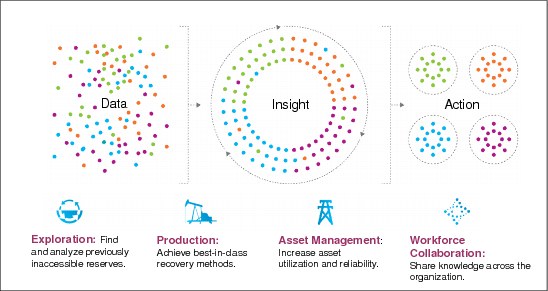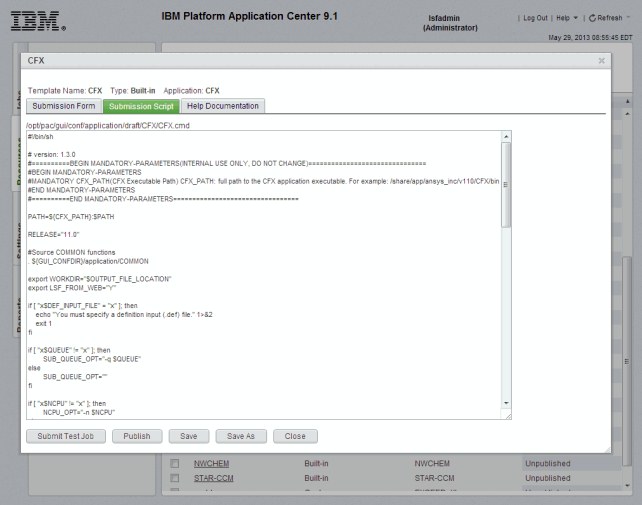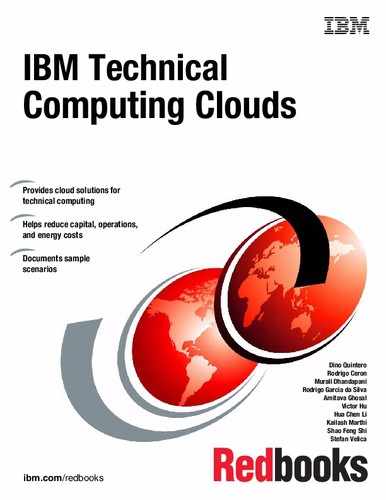

Solution for oil and gas workloads
This chapter provides an architecture reference for oil and gas workloads to be deployed on a technical cloud-computing environment.
This chapter includes the following sections:
10.1 Overview
The current economic scenario drives the oil and gas industry to pursue new approaches to improve discovery, production, and recovery rates.
There is a complex set of industry forces that are acting in today’s oil and gas companies:
•Energy supply and demand volatility places pressure on production effectiveness.
•Production complexities push the limits of current technologies and best practices.
•A changing workforce requires increased productivity and knowledge transfer.
•New technologies provide opportunities, but require operational changes.
•Capital and operating expense uncertainty makes it difficult to assess economic viability of assets.
•Risk and compliance pressures intensify as regulations tighten.
•Environmental concerns put industry practices under extreme scrutiny.
•Rising energy needs require new approaches to extend the life of existing fields while also finding and developing new fields.
The demand for innovation creates opportunities to push information technology (IT) boundaries:
•Greater access to shared, centralized resources for faster insight to complex challenges, with improved efficiency and reduced costs.
•Improved collaboration by using remote access to increase knowledge sharing, unlocking skills from location and using portable devices.
•Improved data management and security through centralized tiered storage solutions.
•Increased operational agility and resiliency through expert integrated systems to support faster time to value.
Figure 10-1 illustrates the trends in the oil and gas industry caused by these driving factors.

Figure 10-1 Trends in the oil and gas industry
10.1.1 Enhance exploration and production
A smarter computing approach to exploration and production results in four focus areas that match the needs that are described in Table 10-1.
Table 10-1 Focus areas to address oil and gas exploration and production needs
|
Focus area
|
Need
|
Purpose
|
|
User access
|
•Clients for 2D/3D remote engineering desktops, standard browsers
|
Supporting anytime, anywhere, collaboration work
|
|
Process management of control systems
|
•General computing on consolidated, virtualized, expert integrated systems
|
Greater agility, scalability, efficiency, and availability at reduced cost
|
|
Numerical analysis and 3D visualization
|
•Technical computing clusters and clouds, with support for accelerators and coprocessors
•Strong workload management
|
Improved time to market by using improved analytical and operational insight
|
|
Global file systems and scalable storage (block and file)
|
•Shared, centralized, tiered storage
•Active file management between strategic data center locations
|
Efficient content movement, management, and worldwide access to valid data sources
|
Technical computing clouds target these specific focus areas, and address some of the critical needs of the clients in the oil and gas industry.
10.1.2 Workloads
The upstream oil and gas industry focuses on the discovery and harvesting of reservoirs of petroleum around the world.
A component of their stock price is in their reserves. In other words, the amount of petroleum that they have discovered and that has a certain revenue potential.
Every year oil companies sell a certain number of millions of barrels of oil. These companies hope to find and explore reserves in excess of the current production to show that their business will grow in the future. There is a lot of pressure on reserve replacement because oil reserves are getting harder to find.
The data coming from oil exploration is exploding, doubling every year in terms of the data footprint. Furthermore, this trend is expected to go up dramatically.
Converting field data to 3D images
The largest application area is seismic imaging, which is the development of 3D pictures of the subsurface of the earth so that geophysics can determine the presence of oil or gas reservoirs. The next step in the process is called reservoir simulation, which simulates the recovery of oil from that reservoir. This is a commercial exercise to determine that the reservoir is commercially viable in terms of the kind of expenses that people must make to recover it.
Seismic imaging
This is an acoustic based process where, in the case of marine-based or ocean-based seismic imaging, large vessels use an acoustic gun to fire sound waves through the surface of the earth. The waves are reflected back up, captured, and the associated acoustic data is then run through software algorithms that convert the time base acoustic image into a 3D image of the subsurface.
This process uses traditional Fast Fourier Transform (FFT) algorithms that were invented in the 1800s. Many of these applications were envisioned in the 1930s and have been improved in terms of better resolution of the layers of the earth. The algorithm is extremely parallel, and can achieve much better performance running on large high-performance computing (HPC) cluster with little internode messaging requirements.
The resolution quality has always depended on the speed of computers available to run it. But as computers get faster, the quality of the imaging can be better and better by using more complex algorithms.
In fact, these algorithms have already been envisioned through all the way to what is called direct inversion. Today companies typically use an algorithm called Reverse Time Migration (RTM), which is fairly complex. To run adequate volumes requires the use of large computing facilities.
|
Note: Reverse Time Migration (RTM) is the most common high end application that is used in upstream petroleum. It is characterized by modeling both the downward and upward acoustic waves as they travel down through the layers of the earth and are reflected back by the various layers.
|
RTM might be the answer to many of today’s problems, but researchers must also run a larger list of applications in the future to run imaging with better resolution than today.
The following is a list of applications that oil companies research departments use:
•Full waveform inversion
•3D internal multiples attenuation
•Iso/VTI FWI
•Integrated imaging/modeling
•TTI FWI
•Real-time 3D RTM
•Viscoelastic FWI
•Inverse scattering series
•Direct inversion (Real FWI)
Also, the research divisions of oil companies have started application development road maps that will result in exascale projects by the end of the decade. So on the seismic imaging side, the road map is going to require processing power up a thousand times greater than used today.
Reservoir simulation
The economic and technical model of a reservoir are fundamental for determining drill decisions and planning. The algorithms that are used are less parallel, and usually demand large amounts of memory per node. Large shared memory systems and high-bandwidth interconnect such as InfiniBand are required to deliver the best results.
On the reservoir simulation side, growth is driven by the need to create simulations with a greater resolution, but also rerunning these simulations many times in a Monte Carlo type approach to provide a better analytical approach.
10.1.3 Application software
Seismic imaging is very different from reservoir simulation because many oil companies develop their own seismic imaging products in-house because they feel they can achieve a significant competitive advantage by doing so. Companies with larger development budgets have research departments that develop new seismic imaging algorithms and implement them into software that they use to develop their own seismic imaging processes and products.
On the reservoir simulation side, companies tend to accept independent software vendor (ISV) software more readily. There is also ISV software for seismic imaging, but the ISV software adoption is much more widespread on the reservoir simulation side.
Table 10-2 shows the leading vendors in the upstream oil and gas industry. Schlumberger WesternGeco does seismic imaging, and Schlumberger Information Solutions provides reservoir simulation and desktop software for geophysics and geologists. Similarly, Halliburton Landmark Graphics is a full range software vendor, and Computer Modeling Group is predominately a reservoir simulation provider. Paradigm Geophysics is predominately a seismic imaging provider.
Table 10-2 Independent software vendors and applications for seismic imaging
|
ISV
|
Applications
|
|
Schlumberger WesternGeco
|
•OMEGA family of seismic processing software (200 programs)
|
|
•RTM ported to GPGPUs
|
|
|
Schlumberger Information Solutions
|
•ECLIPSE Reservoir Simulation Software
|
|
•Petrell
|
|
|
•Intersect
|
|
|
Halliburton Landmark Graphics
|
•SeisSpace
|
|
•ProMax
|
|
|
•VIP
|
|
|
Computer Modeling Group (CMG)
|
•STARS Heavy Oil Simulator
|
|
Paradigm GeoPhysics
|
•EPOS IV Seismic Imaging
|
10.2 Architecture
There is much interest in employing the cloud model (in technical computing) to the oil and gas industry. However, little cloud implementation has occurred thus far because these systems tend to be so massive that current commercial cloud offerings do not have the capacity for their computing requirements.
Figure 10-2 shows that petroleum exploration pipeline is quite complex and poses some considerable challenges to end-to-end cloud implementation.

Figure 10-2 Petroleum exploration and production processing and data lifecycle
However, there are considerable benefits in applying a private cloud model to some steps of the process, specially in the area of remote 3D visualization and collaboration. Most of the visualization software and tools used in both seismic imaging and reservoir simulation can use the 3D desktop virtualization architecture described in Chapter 7, “Solution for engineering workloads” on page 139.
10.2.1 Components
This section describes the solution components.
IBM Platform Application Center (PAC) remote visualization
IBM Platform Application Center Standard Edition provides not only basic job submission, and job and host monitoring, but also default application templates, role-based access control, reporting, customization, and remote visualization capabilities.
PAC can help reduce application license cost by increasing license utilization. With fine-tuned licensing scheduling policies, PAC and licensing scheduler can help companies optimize use of expensive reservoir simulation software licenses.
Application templates are used to integrate applications. You can use the built-in templates to immediately submit jobs to the specific applications.
|
Note: Generally, the name of the template indicates the name of the application to which jobs can be submitted.
|
Tested applications
PAC provides some built-in application templates for oil and gas industry applications. Table 10-3 lists the versions of applications that have been tested with Platform Application Center.
Table 10-3 Tested applications for the oil and gas industry
|
Applications
|
Tested versions
|
|
CMGL_GEM
|
•2008.12
•2009.13
|
|
CMGL_IMEX
|
•2008.11
•2009.11
|
|
CMGL_STARS
|
•2008.12
•2009.11
|
|
ECLIPSE
|
•2009.1
•2010
|
|
STAR-CCM+
|
•6.02
|
|
Note: These are tested application versions. Job submission forms can be customized to support other versions.
|
Submission forms and submission scripts
Application templates have two components:
Submission form The job submission form is composed of fields. Each field has a unique ID associated with it. IDs must be unique within the same form.
Submission script The job submission script uses the same IDs as the submission form to pass values to your application.
Customizing application templates
You can customize application templates by adding or removing fields, rearranging fields, and entering default values for fields. You can also change field names and add help text for fields. Figure 10-3 shows the submission form editing window for the ECLIPSE built-in template.
In addition, you can create hidden fields, which are fields that are only visible to you, the administrator. These can hold default values for the submission forms. Users cannot see hidden fields in their forms.

Figure 10-3 Application template for ECLIPSE
Figure 10-4 shows the submission script editing window for the CFX built-in template in PAC.

Figure 10-4 CFX submission script editing window
|
Note: For more information about PAC application templates configuration and remote visualization setup, see Administering Platform Application Center, SC22-5396-01.
|
..................Content has been hidden....................
You can't read the all page of ebook, please click here login for view all page.
